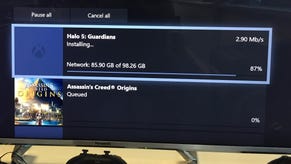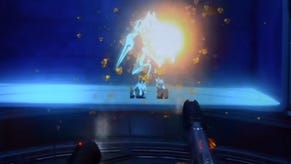Can Halo 5 deliver on its 60fps promise?
Digital Foundry assesses 343 Industries' E3 showing.
Echoing the reveal of its predecessor three years ago, Microsoft kicked off its E3 media briefing this year with a first look at Halo 5: Guardians' single-player campaign. A new approach to mission design and a host of new characters combine with a fresh coat of paint to present something that feels both new and familiar. Last December's multiplayer beta already highlighted a number of changes to the core formula, but it's only with this new demo that we're able to fully appreciate this new direction and to get a real idea of the full scope of 343's vision for its first true 'next-gen' Halo.
Many of the key improvements seen in Halo 5 are the result of its newly redesigned technical underpinnings. This is only the second time in series history that Halo has made the jump to a new, more powerful platform and 343's newly rebuilt engine is built with ambitious targets in mind. With a renewed focus on lighting, effects work and higher performance, the new tech promises a substantial evolution over Halo 4. A new materials system, making use of physically-based rendering, helps bring newfound realism to the world of Halo - and its key benefits are evident in this demo. Metal takes on a realistic sheen while more diffuse materials sit naturally within the world. While we spotted a fair number of low resolution textures, there's still a strong sense that 343 is moving in the right direction.
Of course, the real game-changer here is performance. For the first time, Halo 5 is built from the ground up with 60fps gameplay in mind. However, the question of whether 343 can hit that target with an acceptable level of consistency is still open to question, based on the E3 showing. While last year's multiplayer beta turned in relatively solid frame-rates, the conference campaign footage raises some concerns. Based on the demo, it seems that the target is a 'perceptual' 60fps experience more in line with the Call of Duty titles. That is, while the target remains 60fps, performance levels often dip below during action sequences.
The question is to what extent 343 will allow performance to deviate from the desired frame-rate - and right now, to be brutally frank, the E3 experience is some way off the level of consistency we want from the final game. This could wind up becoming a real issue if there isn't sufficient improvement: right now, only the quietest of moments delivers a completely stable frame-rate: every battle sequence in the demo suffers from noticeable drops - something we observed not just in the media briefing live demo, but in 343's own b-roll footage.
There has also been a lot of discussion centered around the notion that Halo 5's background simulation hinges on its frame-rate. Under the handle "Stinkles" on NeoGAF, series development director Frank O'Connor wrote about the controversial decision to drop split-screen support, "Yes, it's a bummer but 60fps had to take precedence. It's not just aesthetics - the entire simulation is built on that frame-rate". However, after viewing the latest E3 demo, this comment leaves us a little confused. The demo regularly drops below its 60fps target but if the simulation were tied so closely to frame-rate, one would imagine that related issues like slow-down would crop up as a result. This is obviously nothing more than speculation on our part, but it certainly seems possible for the game to operate at 30fps - and certainly the notion of simulation systems operating at much higher tick-rates than the rendering is nothing new: Forza Motorsport is just one title that uses a similar system, after all.
There's a key reason why a lower frame-rate could make sense for the game - and it comes back to the decision to drop split-screen gameplay. 343 itself has stated that split-screen gameplay would compromise the vision and performance levels it is targeting. It's clear that 60fps in split-screen would be a massive challenge, but certainly from our perspective, running this mode at a consistent, lower frame-rate wouldn't be a major problem - and it would be preferable to not having it at all. After all, Halo split-screen was always popular, despite failing to deliver a particularly smooth experience in previous series outings. Removing a staple feature like this is disappointing and the Halo fanbase is already up in arms. There is still some faint hope on the horizon with Microsoft General Manager of Games Publishing Shannon Loftis suggesting that we should "never say never", but grounds for genuine optimism right now on this front seem limited.
It's clear that performance is an important focus for Halo 5 and we applaud 343 for committing to a top-tier 60fps target when so many other games ship at 30fps or below. Keeping this goal in mind lends additional credibility to a wealth of evidence suggesting that 343 is experimenting with a dynamic resolution framebuffer. By adjusting pixel count based on engine load, this feature could allow Halo 5 to maintain a higher frame-rate at the expense of image quality during action heavy sequences. In its current form, this is clearly evident both in campaign and Warzone footage. In theory, it sounds like a promising solution, but Frank O'Conner again cautions that "there's zero permanent resolution information to take away from E3."
The current dynamic frame resolution system can actually be observed in more detail within the 'Road to E3' video published on the Halo Channel a few weeks back, and embedded below. It provides a closer look at the game in a debug state, complete with important performance statistics visible on-screen, as the camera is flown in and around the environment. We can see the horizontal resolution apparently shift dynamically between a full 1920 all the way down to 832 pixels. With 810 vertical lines in play we're looking at a resolution ranging from 1920x810 to 832x810. However, in b-roll distributed during E3, minimum resolution observed comes in at 1152x810 - not exactly wonderful but presumably more indicative of where the system is right now during gameplay.
The drive to optimise performance has implications elsewhere. Independent of rendering resolution, we also see plenty of low-resolution transparent alpha effects. Smoke and particles are rendered at a resolution low enough to produce noticeable saw-tooth edges where they intersect with the silhouette of the view weapon. This could be the key to delivering a stable 60fps experience, and right now it does seem that 343 is running the gamut of well-known techniques designed to ease up on GPU utilisation.
There is another potential compromise made in an effort to hit this frame-rate - map size. Halo 4 already sacrificed the massive open areas of Bungie's releases in order to hit a new level of visual fidelity on Xbox 360. There was the hope that transitioning to Xbox One would enable the team to deliver larger, more open map design but to date, we haven't seen anything quite on par with the previous developer's outings. This is nothing more than an observation on our part based on media revealed thus far, so it's entirely possible such missions will appear in the final game. However, the new material - in combination with what we saw previously in the beta - does seem to suggest that the strategy decided upon for Halo 4 extends to the sequel too.
However, there are some clear breaks with the past in the new title that look intriguing. Previous Halo games were always heavy on cut-scene usage but with Halo 5, we note the inclusion of seamless first-person transitions between cut-scene and gameplay. This approach helps keep the player rooted in the action, preventing the game from becoming overly segmented by its story beats. The audio also seems to be heading in the right direction with a whole new suite of sound effects on offer, alongside some nice musical cues.
But on balance, it's the aforementioned gameplay additions that truly seem to have changed the game. Sprinting, aiming down sights, and ledge grabbing are all prominently featured in the E3 demo, but the largest change comes from the new squad system. This should come as no surprise since the game's creative director, Tim Longo, also directed one of the best Star Wars games to date - the squad-based Republic Commando. For our money, this is actually one of the most interesting changes to the formula. Including a streamlined command system in the game allows it to take a slightly different approach to combat that could result in some interesting, fresh scenarios. This new direction may be cause for concern to some long-term Halo fans, but the bottom line is this: after so many years with the franchise, it is time to try something new - and the transition to a new hardware platform is the perfect time to experiment with the formula.
In many ways, Halo 4 felt like a passing of the torch from Bungie to 343 Industries: a transition both in terms of technology and design. 343's debut put the stake in the ground, it was the starting point from which future titles would be defined. With Halo 5, the transition is complete. The Master Chief's next outing is 343 Industries through and through, a creation that casts aside many of its Bungie roots in favour of a fresh take on the classic gameplay, forged through years of experience. The multiplayer beta released late last year gave us a taste of these changes with a newfound focus on performance, innovative gameplay features, and new technology while the E3 demo further cements this new focus. If the final game can deliver on the promise of a stable 60fps frame-rate across all modes while offering compelling mission design, we could be looking at one of the best shooters of the year.

















